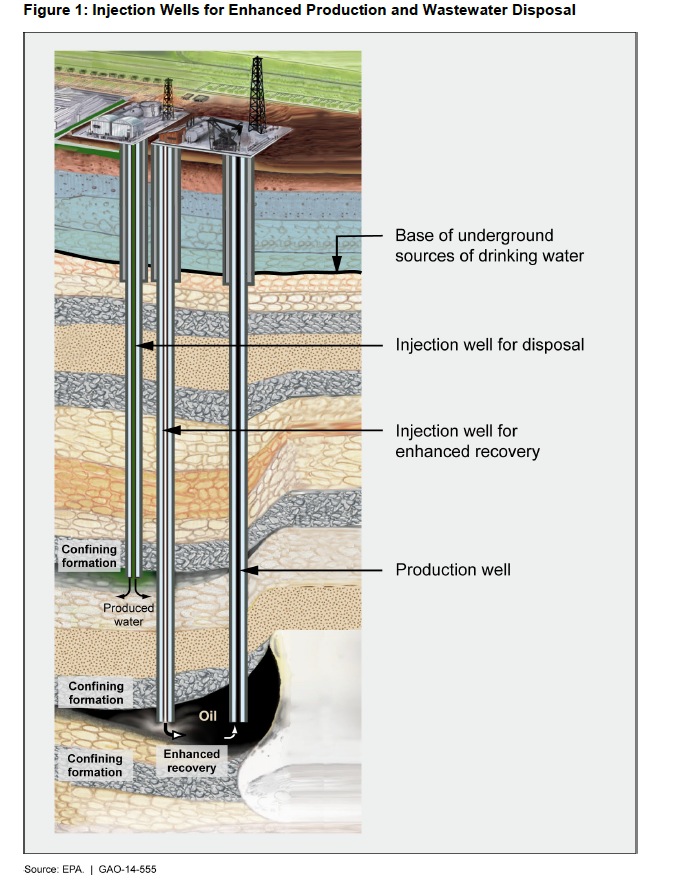UNITED STATES GOVERNMENT ACCOUNTABILITY OFFICE
Why GAO Did This Study
Every day in the United States, at least 2 billion gallons of fluids are injected into over 172,000 wells to enhance oil and gas production, or to dispose of fluids brought to the surface during the extraction of oil and gas resources. These wells are subject to regulation to protect drinking water sources under EPA’s UIC class II program and approved state class II programs. Because much of the population relies on underground sources for drinking water, these wells have raised concerns about the safety of the nation’s drinking water.
GAO was asked to review EPA’s oversight of the class II program. This report examines (1) EPA and state roles, responsibilities, and resources for the program, (2) safeguards to protect drinking water, (3) EPA oversight and enforcement of class II programs, and (4) the reliability of program data for reporting. GAO reviewed federal and state laws and regulations. GAO interviewed EPA and state officials and reviewed class II programs from a nongeneralizable sample of eight states selected on the basis of shale oil and gas regions and the highest number of class II wells.
What GAO Recommends
GAO recommends that, among other things, EPA review emerging risks related to class II program safeguards and ensure that it can effectively oversee and efficiently enforce class II programs. EPA agreed with all but the enforcement recommendation. GAO continues to believe that EPA should take actions to ensure it can enforce state class II regulations, as discussed in the report.
What GAO Found
The Environmental Protection Agency’s (EPA) role in the Underground Injection Control (UIC) class II program is to oversee and enforce fluid injection into wells associated with oil and gas production, known as class II wells. EPA has approved 39 states to manage their own class II programs, and EPA regions are responsible for managing the programs in remaining states. EPA regions and states use a mix of resources to manage class II programs, including EPA grant funding, state funding, and federal and state personnel. EPA’s UIC grant funding has remained at about $11 million for at least the past 10 years.
Class II programs from the eight selected states that GAO reviewed have safeguards, such as construction requirements for injection wells, to protect against contamination of underground sources of drinking water. Programs in two states are managed by EPA and rely on EPA safeguards, while the remaining six programs are state managed and have their own safeguards that EPA deemed effective at preventing such contamination. Overall, EPA and state program officials reported that these safeguards are protective, resulting in few known incidents of contamination. However, the safeguards do not address emerging underground injection risks, such as seismic activity and overly high pressure in geologic formations leading to surface outbreaks of fluids. EPA officials said they manage these risks on a state-by-state basis, and some states have additional safeguards to address them. EPA has tasked its UIC Technical Workgroup with reviewing induced seismicity associated with injection wells and possible safeguards, but it does not plan reviews of other emerging risks, such as high pressure in formations. Without reviews of these risks, class II programs may not have the information necessary to fully protect underground drinking water.
EPA is not consistently conducting two key oversight and enforcement activities for class II programs. First, EPA does not consistently conduct annual on-site state program evaluations as directed in guidance because, according to some EPA officials, the agency does not have the resources to do so. The agency has not, however, evaluated its guidance, which dates from the 1980s, to determine which activities are essential for effective oversight. Without such an evaluation, EPA does not know what oversight activities are most effective or necessary. Second, to enforce state class II requirements, under current agency regulations, EPA must approve and incorporate state program requirements and any changes to them into federal regulations through a rulemaking. EPA has not incorporated all such requirements and changes into federal regulations and, as a result, may not be able to enforce all state program requirements. Some EPA officials said that incorporating changes into federal regulations through the rulemaking process is burdensome and time-consuming. EPA has not, however, evaluated alternatives for a more efficient process to approve and incorporate state program requirements and changes into regulations. Without incorporating these requirements and changes into federal regulations, EPA cannot enforce them if a state does not take action or requests EPA’s assistance to take action.
EPA collects a large amount of data on each class II program, but the data are not reliable (i.e., complete or comparable) to report at a national level. EPA is working on a national database that will allow it to report UIC results at a national level, but the database will not be fully implemented for at least 2 to 3 years.
About the US Government Accountability Office
www.gao.gov
The U.S. Government Accountability Office (GAO) is an independent, nonpartisan agency that works for Congress. Often called the “congressional watchdog,” GAO investigates how the federal government spends taxpayer dollars. The head of GAO, the Comptroller General of the United States, is appointed to a 15-year term by the President from a slate of candidates Congress proposes. Gene L. Dodaro became Acting Comptroller General of the United States on March 13, 2008, succeeding David M. Walker, who appointed him upon resigning. Gene L. Dodaro became Comptroller General of the United States and head of the U.S. Government Accountability Office (GAO) on December 22, 2010, when he was confirmed by the United States Senate. He was nominated by President Obama in September of 2010 and had been serving as Acting Comptroller General since March of 2008.
Tags: Environmental Protection Agency, Gas, Oil, Petroleum, United States Government Accountability Office, US GAO







 RSS Feed
RSS Feed